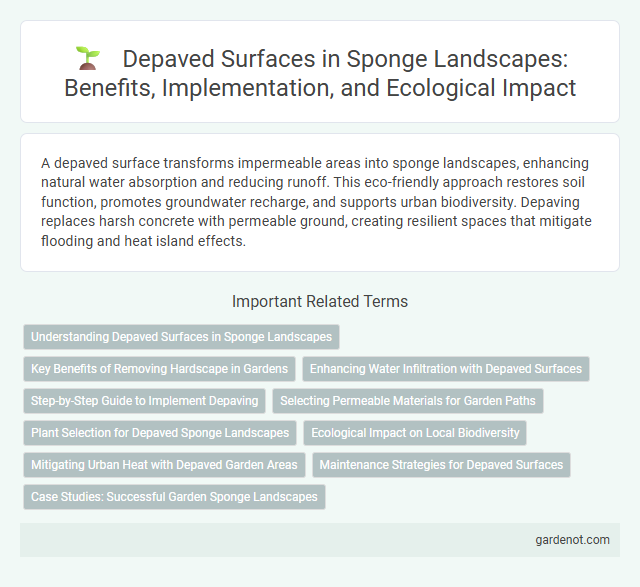A depaved surface transforms impermeable areas into sponge landscapes, enhancing natural water absorption and reducing runoff. This eco-friendly approach restores soil function, promotes groundwater recharge, and supports urban biodiversity. Depaving replaces harsh concrete with permeable ground, creating resilient spaces that mitigate flooding and heat island effects.
Understanding Depaved Surfaces in Sponge Landscapes
Depaved surfaces in sponge landscapes involve removing impervious materials like asphalt or concrete to restore natural soil permeability, enhancing rainwater infiltration and reducing runoff. These surfaces facilitate groundwater recharge and promote sustainable urban drainage systems by allowing water to seep directly into the ground. Understanding depaved surfaces is essential for improving stormwater management and mitigating urban flooding impacts effectively.
Key Benefits of Removing Hardscape in Gardens
Removing hardscape in gardens, such as depaved surfaces, significantly enhances water infiltration and reduces surface runoff, promoting groundwater recharge and mitigating flooding risks. This transformation fosters healthier soil ecosystems by allowing roots to access oxygen and nutrients more effectively, leading to increased plant growth and carbon sequestration. It also improves urban biodiversity by creating permeable, natural habitats that support insects, birds, and other wildlife.
Enhancing Water Infiltration with Depaved Surfaces
Depaved surfaces significantly enhance water infiltration by removing impervious materials such as concrete or asphalt, allowing rainwater to penetrate the soil naturally. This process reduces surface runoff, mitigates urban flooding, and replenishes groundwater reserves. Incorporating depaved areas in sponge landscapes improves soil permeability and supports sustainable stormwater management.
Step-by-Step Guide to Implement Depaving
Removing impervious surfaces through depaving restores natural water absorption and reduces runoff, enhancing urban sponge landscape effectiveness. Begin by assessing the area for drainage issues, then carefully break up and remove concrete or asphalt, ensuring to preserve soil integrity beneath. Refill the exposed soil with permeable materials like compost and native plants to maximize water infiltration and support sustainable urban ecosystems.
Selecting Permeable Materials for Garden Paths
Choosing permeable materials such as gravel, permeable pavers, or crushed stone for garden paths enhances water infiltration and reduces runoff in sponge landscape designs. These materials support natural groundwater recharge by allowing rainwater to percolate through the surface, preventing soil erosion and minimizing flood risks. Incorporating permeable paths improves the overall sustainability and resilience of urban green spaces by managing stormwater effectively.
Plant Selection for Depaved Sponge Landscapes
Selecting appropriate plant species for depaved sponge landscapes enhances soil permeability and water retention, crucial for stormwater management. Native grasses, sedges, and deep-rooted perennials like switchgrass (Panicum virgatum) and blue flag iris (Iris versicolor) excel in these conditions by stabilizing soil and promoting infiltration. Emphasizing drought-tolerant and pollution-absorbing plants ensures resilience and improved ecosystem services within depaved urban environments.
Ecological Impact on Local Biodiversity
Depaved surfaces in sponge landscapes restore natural soil infiltration, significantly enhancing water retention and reducing runoff pollution that harms aquatic habitats. Removing impervious layers promotes native vegetation growth, which provides essential habitat for local wildlife and increases overall biodiversity. This ecological restoration supports pollinators, birds, and soil microorganisms, fostering a more resilient and balanced ecosystem.
Mitigating Urban Heat with Depaved Garden Areas
Depaved surfaces in urban sponge landscapes help mitigate heat by replacing impermeable concrete or asphalt with permeable, vegetated garden areas that increase evapotranspiration and reduce surface temperatures. These depaved green spaces improve stormwater infiltration, lower urban heat island effects, and enhance local microclimates. Incorporating strategic depaving supports sustainable urban design by promoting cooler environments and better water management.
Maintenance Strategies for Depaved Surfaces
Effective maintenance strategies for depaved surfaces involve regular monitoring to prevent soil compaction and erosion, ensuring optimal water infiltration in sponge landscapes. Implementing periodic regrading and the addition of permeable materials enhance surface permeability and structural integrity. Routine removal of debris and invasive vegetation supports the longevity and ecological function of depaved areas.
Case Studies: Successful Garden Sponge Landscapes
Depaved surfaces in sponge landscape projects transform impermeable areas into permeable green spaces that enhance stormwater management and biodiversity. Case studies such as Seattle's Depave Project demonstrate how removing concrete and replacing it with native plants significantly improves water infiltration and reduces urban heat island effects. These successful garden sponge landscapes serve as scalable models for sustainable urban design and ecological restoration.
Depaved surface Infographic

 gardenot.com
gardenot.com